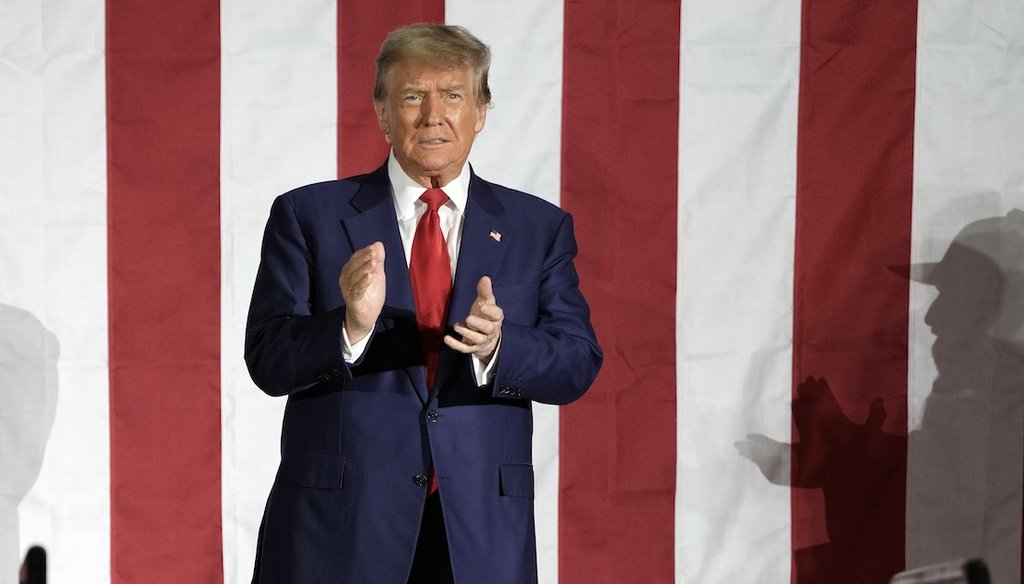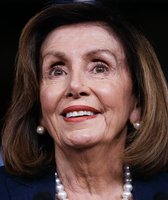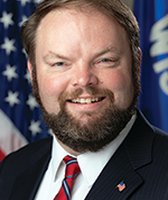Stand up for the facts!
Our only agenda is to publish the truth so you can be an informed participant in democracy.
We need your help.
I would like to contribute

Former President Donald Trump arrives at a campaign rally in Waukesha, Wis., on May 1, 2024. (AP)
Former President Donald Trump at May 1 rallies in Wisconsin and Michigan — battleground states with high numbers of manufacturing jobs — highlighted his vision for the economy.
Trump made misleading statements about tax cuts and jobs filled by immigrants in the U.S. illegally, but spoke more accurately on the rising costs of food, including chicken.
Thronged by thousands of his supporters, Trump told jokes and attacked President Joe Biden’s demeanor and record on jobs and the economy. Trump’s appearance was a marked departure from the Manhattan courtroom, where he has been required to sit silently for hourslong stretches during the first of up to four criminal trials.
"When I’m in the White House, the Biden economic bust will quickly be replaced with the Trump economic boom," Trump said in Waukesha, Wisconsin.
Here are our fact-checks of his statements on the economy, which voters often tell pollsters is their top concern.
"The people that benefited the most (from the tax cuts Trump signed) are lower-income people," and Biden "wants them to expire."
The first part of this statement is wrong; the second is misleading.
The part about low-income taxpayers benefiting more "is not correct," based on modeling from the Urban Institute-Brookings Institution Tax Policy Center and other think tanks, said John Buhl, the Tax Policy Center’s communications director.
The Tax Policy Center analysis found that the Trump-signed legislation would, on average, cut taxes for households in each income group, but that taxpayers in higher-income households would see the biggest benefits.
For instance, the lowest one-fifth of taxpayers — people earning up to $25,000 — would see their average federal tax rate drop by 0.4 percentage points in 2018. The drop in tax rate would be larger for each successive one-fifth of the income spectrum, with the top one-fifth seeing its tax rates drop by 1.8 percentage points. The biggest gains would go to households in the top 1% to 5% of incomes (from $307,900 to $732,000); their tax rates would drop by 3.1 percentage points.
The numbers were similar for changes through 2025, the Tax Policy Center found.
On whether Biden wants to get rid of the tax cuts, Trump appeared to refer to brief remarks Biden made about the Trump tax cuts in April, when he said, "It’s going to expire. And if I’m reelected, it’s going to stay expired."
However, Biden has said repeatedly that he will not raise taxes on anyone making less than $400,000, a promise he campaigned on in 2020. The White House told PolitiFact that Biden would let the Trump tax cuts expire for wealthier taxpayers but would not let Americans making less than $400,000 see any tax increase.
"A lot of the numbers … that just came out on immigration and unemployment (showed that) all of the numbers were from illegal immigrants."
There are significant problems with this statement.
The employment of foreign-born workers is relatively small — in 2023, foreign-born workers accounted for just less than 20% of all workers — but the count has been growing for years, especially since the pandemic.
The federal government counts the data for foreign-born and native-born employment using a survey of households. From month to month, the data tends to whipsaw because the survey has a sizable margin of error.
Looking at just the most recent month-to-month changes, as Trump said he was doing, the increase in native-born employment (929,000) from February 2024 to March 2024 was more than eight times larger than the increase in foreign-born employment (112,000) over the same period. Those numbers contradict what Trump said.
To iron out the data, we previously looked at a longer period: Biden’s presidency. From February 2021 to February 2024, native-born employment rose by almost 5.7 million workers. That was a larger increase than the 5.1 million for foreign-born workers. So, the increase in foreign-born workers was substantial, and disproportionate to their share of the overall labor force, but it was not "all," as Trump said.
Trump is also off base in saying the entire increase in employment came from "illegal immigrants." The statistics for the foreign-born workforce are much broader than "illegal immigrants" or recent migrants. They also include many people who immigrated to the U.S. legally and have been U.S. citizens for decades and people here as legal permanent residents, or green card holders.
Under Biden, "chicken — I love chicken — is up 24%. Baby food is up 30%. Eggs are up 59%. Gasoline is up 50%. … Airfares are up 33%"
Trump is pretty close with most of the price increases he cited.
-
The price for boneless chicken breasts rose by 26% from Biden’s January 2021 inauguration to March 2024.
-
The price for canned baby foods (a category that includes some other specialty foods) rose by 30% over the same period.
-
A dozen Grade A large eggs more than doubled in price.
-
Gasoline prices rose by 53%.
During the same period, wages rose by almost 16%, so the costs of each of these items rose faster than wages.
The most misleading of Trump’s price statistics is airline fares. Airline fares are 27% higher now than they were when Biden took office. But Biden became president when the pandemic had dampened demand for interstate travel, so the January 2021 prices were artificially low by historical standards.
Airfares are cheap by historical standards. The current price level for airline tickets is almost identical to where it was during Trump’s tenure, and it’s mostly lower than it was for most of Barack Obama’s presidency. Having airfares lower than they were in the early-to-mid 2010s means that prices have eased rather than risen.
"And I already gave you the largest tax cut in the history of our country, larger than the Reagan tax cuts many years ago. You got the largest tax cuts in history."
This is a falsehood Trump shared repeatedly during his presidency. (Our colleagues at the Washington Post Fact Checker found that this was Trump’s second-most-commonly repeated false claim, shared 295 times during his presidency.)
In inflation-adjusted dollars, the tax bill Trump signed was the fourth-largest since 1940, and as a percentage of GDP, it ranked seventh.
"GDP growth was plunging by more than 50% in the first quarter of this year."
Trump is right on the numbers. However, to the layperson, his framing might make this drop sound more alarming than it is.
In 2023’s fourth quarter, gross domestic product rose by 3.4% on an annualized basis. In 2024’s first quarter, it rose by 1.6%.
But GDP itself did not plunge by 50%; that would have represented a massive economic calamity. GDP continued to grow, but half as fast as it did in the previous quarter. Also, it had further to fall in 2024’s first quarter: The 3.4% growth in the previous quarter represented the second-fastest-growing quarter since the start of 2022.
The U.S. is experiencing "record kinds of inflation."
Although inflation is still considered an economic problem for the U.S., the overall rate is nowhere near a record.
The highest inflation rates were recorded in the 1970s and early 1980s, when the annual price increase sometimes hovered between 12% and 15%. The highest rate on Biden’s watch was around 9% in summer 2022. That was the highest monthly figure in about four decades, but not the highest ever.
Inflation was 3.5% in March 2024, the most recent month available. The Federal Reserve believes that’s still too high to start lowering interest rates — the Fed wants to see sustained inflation rates closer to 2% — but the current level is still about two-thirds lower than its 2022 peak.
"By 2030 (Biden) wants everyone to have an electric vehicle."
This is an exaggeration.
The Biden administration set a goal — not a mandate — to have electric vehicles comprise half of all new vehicle sales by 2030. It’s currently at about 8%.
In March, the administration finalized a rule that projects 30% to 56% of new light-duty vehicles will be battery-electric by 2032. That means that consumers could still buy some gasoline-powered cars, both new and used, by 2032, or hybrids.
"There is no federal requirement that any particular percentage of an automaker's fleet needs to be electric," Jeremy Michalek, director of the Carnegie Mellon Vehicle Electrification Group, said. "Our recent work suggests that consumers haven't really changed what they value, but as EV technology gets better, with lower cost and larger range, those same consumers choose EVs more often."
AutoForecast Solutions LLC, a car industry trend forecaster, projects sales of new battery-electric vehicles in the United States will be about 31% by 2031.
There are several challenges to expanding the EV market including the cost to purchase a car, the range the cars can go, the relative lack of charging stations compared with gas stations and the costs of raw materials for building the cars, said Joseph McCabe, president and chief executive officer of AutoForecast Solutions.
RELATED: All of our fact-checks of Donald Trump
RELATED: All of our fact-checks of Joe Biden and Kamala Harris
Our Sources
C-SPAN, Former President Trump Holds Rally in Freeland, Michigan, May 1, 2024
C-SPAN, Former President Trump Holds Rally in Waukesha, Wisconsin, May 1, 2014
U.S. Environmental Protection Agency, Biden-Harris Administration finalizes strongest-ever pollution standards for cars that position U.S. companies and workers to lead the clean vehicle future, protect public health, address the climate crisis, save drivers money, March 20, 2024
White House, FACT SHEET: President Biden Is Fighting to Reduce the Deficit, Cut Taxes for Working Families, and Invest in America by Making Big Corporations and the Wealthy Pay Their Fair Share, March 7, 2024
White House, Remarks by President Biden at the IBEW Construction and Maintenance Conference, April 19, 2024
Cox Automotive, A Record 1.2 Million EVs Were Sold in the U.S. in 2023, According to Estimates from Kelley Blue Book, Jan. 9, 2024
PolitiFact, Donald Trump wrong again that recent tax bill is biggest ever, Jan. 31, 2018
Telephone interview with Joseph McCabe, President & CEO, AutoForecast Solutions LLC, May 2, 2024
Email interview with Michael Kikukawa, White House spokesperson, May 2, 2024
Email interview with Jeremy J. Michalek, director, vehicle electrification group, Carnegie Mellon University, May 2, 2024
Email interview with John Buhl, communications director for the Urban Institute-Brookings Institution Tax Policy Center, May 2, 2024
Email interview with Larisa Manescu, spokesperson for the Sierra Club, May 2, 2024
Other sources linked in article













































